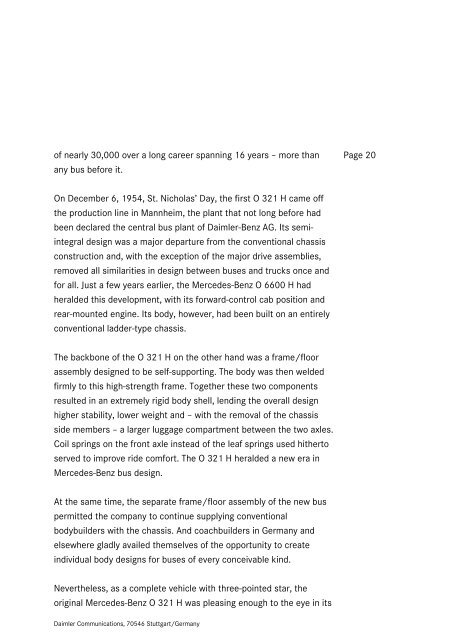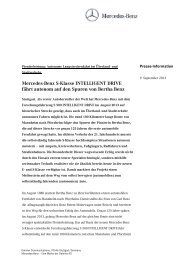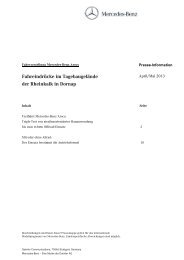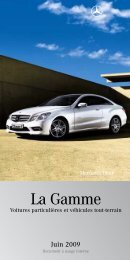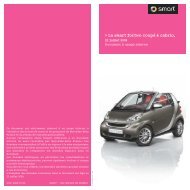Mercedes-Benz Bus History - Daimler
Mercedes-Benz Bus History - Daimler
Mercedes-Benz Bus History - Daimler
Create successful ePaper yourself
Turn your PDF publications into a flip-book with our unique Google optimized e-Paper software.
of nearly 30,000 over a long career spanning 16 years – more than<br />
any bus before it.<br />
On December 6, 1954, St. Nicholas’ Day, the first O 321 H came off<br />
the production line in Mannheim, the plant that not long before had<br />
been declared the central bus plant of <strong>Daimler</strong>-<strong>Benz</strong> AG. Its semi-<br />
integral design was a major departure from the conventional chassis<br />
construction and, with the exception of the major drive assemblies,<br />
removed all similarities in design between buses and trucks once and<br />
for all. Just a few years earlier, the <strong>Mercedes</strong>-<strong>Benz</strong> O 6600 H had<br />
heralded this development, with its forward-control cab position and<br />
rear-mounted engine. Its body, however, had been built on an entirely<br />
conventional ladder-type chassis.<br />
The backbone of the O 321 H on the other hand was a frame/floor<br />
assembly designed to be self-supporting. The body was then welded<br />
firmly to this high-strength frame. Together these two components<br />
resulted in an extremely rigid body shell, lending the overall design<br />
higher stability, lower weight and – with the removal of the chassis<br />
side members – a larger luggage compartment between the two axles.<br />
Coil springs on the front axle instead of the leaf springs used hitherto<br />
served to improve ride comfort. The O 321 H heralded a new era in<br />
<strong>Mercedes</strong>-<strong>Benz</strong> bus design.<br />
At the same time, the separate frame/floor assembly of the new bus<br />
permitted the company to continue supplying conventional<br />
bodybuilders with the chassis. And coachbuilders in Germany and<br />
elsewhere gladly availed themselves of the opportunity to create<br />
individual body designs for buses of every conceivable kind.<br />
Nevertheless, as a complete vehicle with three-pointed star, the<br />
original <strong>Mercedes</strong>-<strong>Benz</strong> O 321 H was pleasing enough to the eye in its<br />
<strong>Daimler</strong> Communications, 70546 Stuttgart/Germany<br />
Page 20


